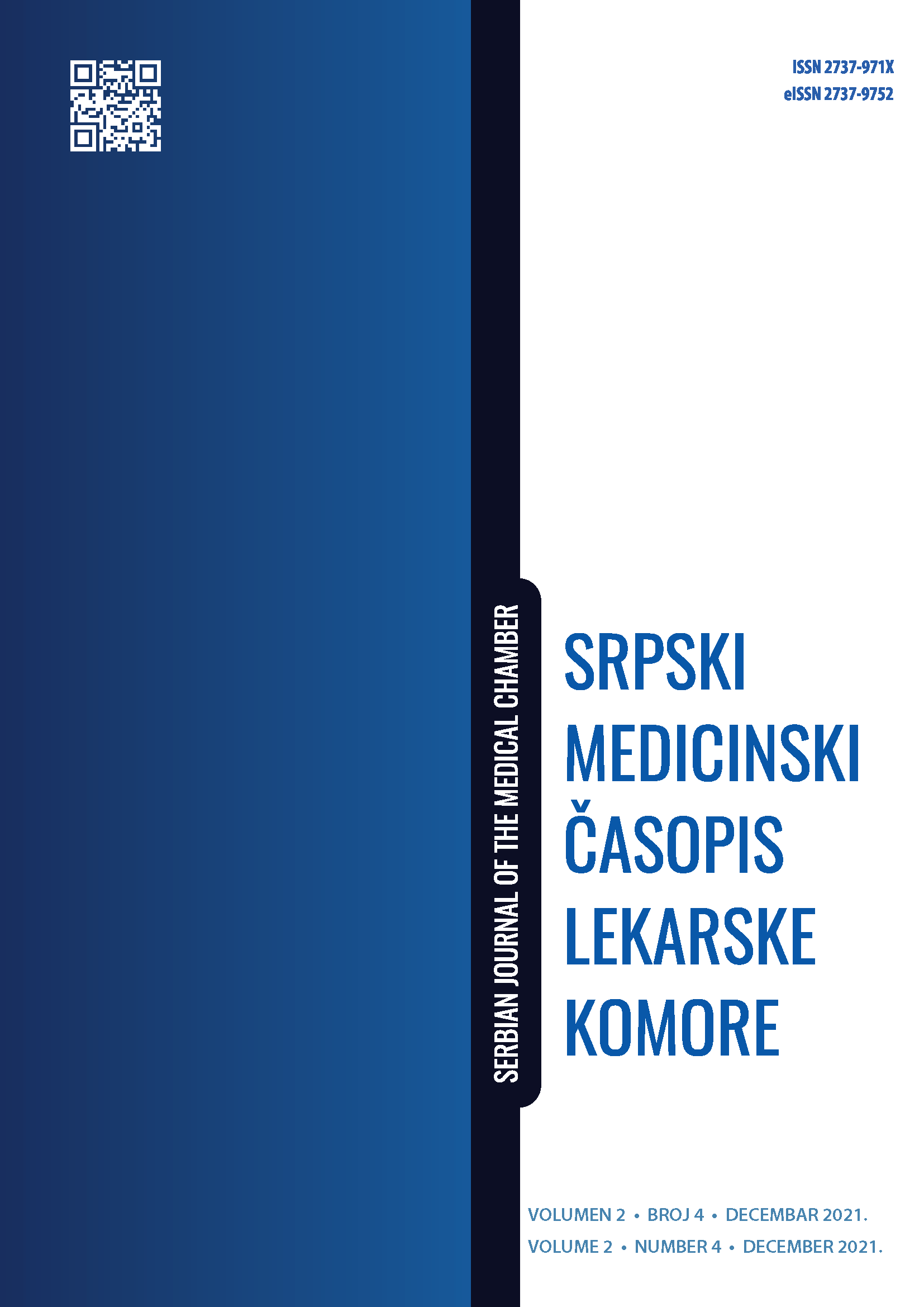INCIDENCE OF INFECTIONS DURING THE APPLICATION OF HIGH-DOSE CHEMOTHERAPY WITH AUTOLOGOUS STEM CELL TRANSPLANTATION
Abstract
Introduction: Autologous stem cell transplantation (AHSCT) is a well-established therapy for hematologic malignancies. Changes in transplantation strategies and improvement in supportive care have significantly altered the incidence and pattern of infections in these patients.
Aim: Evaluating the frequency of infections in the first 30 days after AHSCT, as well as the possible influence of the number of CD34 + stem cells in the graft and of the engraftment parameters: ALC500_20 (absolute lymphocyte count 0.5x109 / L per day + 20), ANC500_11 (absolute neutrophil count 0.5x109 / L per day + 11),
and PLT20_13 (platelets 20x109 / L per day + 13), on the occurrence of infections.
Materials and methods: The retrospective cohort study examined 80 patients above the age of 20 years, diagnosed with multiple myeloma (MM), non-Hodgkin's (NHL) or Hodgkin's lymphoma (HL), treated at the Clinic for Hematology of the Clinical Center of Serbia, in the period between July 2006 and December 2017. All episodes of fever and/or documented infection during neutropenia have been reported.
Results: The average survival after AHSCT was 34.5 months. A total of 54 patients (67.5%) had a documented infection. Gram-positive infections were five times more common than gram-negative. In gram-positive isolates, coagulase-negative staphylococcus – CoNS was the most common (37.0%) pathogen, followed by
Streptococcus α haemolyticus (12.4%). Among gram-negative isolates, Escherichia coli was present in 62.5% of the cases, while Klebsiella spp. and Ralstonia pickettii were represented with an equal frequency of 12.5%. Fungal infections were rare (Candida spp., 10.0%). Viral infections were verified in 5 (6.3%) patients (Herpes
zoster virus 3.8% and H1N1 2.5%).
Conclusion: The number of CD34+ stem cells in the graft, as well as the rate of hematopoietic reconstitution, i.e., the achievement of ALC500_20, ANC500_11, and PLT20_13, were not statistically significant for the development of infections in the early phase after AHSCT.
References
2. Farge D, Labopin M, Tyndall A, et al., Autologous Hematopoietic Stem Cell Transplantation For Autoimmune Diseases: An Observational Study On 12 Years’ Experience From The European Group For Blood And Marrow Transplantation Working Party On Autoimmune Diseases, Haematologica February 2010 95: 284-292
3. Burman J, Tolf A, Hägglund H, et al.,Autologous haematopoietic stem cell transplantation for neurological diseases, Neurol Neurosurg Psychiatry 2018, 89:147–155.
4. Gratwohl A, Passweg J, Baldomero H, Hermans J. Blood and marrow transplantation activity in Europe 1997 Bone Marrow Transplant, 1999, 24: 231–245
5. Barton T, Collis T, Stadtmauer E, Schuster M.Infectious complications the year after autologous bone marrow transplantation or peripheral stemcell transplantation for treatment of breast cancer. Clin Infect Dis. 2001 Feb 1; 32(3):391-5.
6. Auner HW, Zebisch A, Ofner P, Sill H, Linkesch W, Krause R. Evaluation of potential risk factors for early infectious complications after autologous peripheral blood stem cell transplantation in patients with lymphoproliferative diseases. Ann Hematol. 2005;84:532–537.
7. Kolbe K, Domkin D, Derigs HG et al. Infectious complications during neutropenia subsequent to peripheral blood stem cell transplantation Bone Marrow Transplant 1997 19: 143–147
8. Salazar R, Sola C, Maroto P et al. Infectious complications in 126 patients treated with high-dose chemotherapy and autologous peripheral blood stem cell transplantation Bone Marrow Transplant 1999 23: 27–33
9. Nosanchuk JD, Sepkowitz KA, Pearse RN et al. Infectious complications of bone marrow and peripheral stem cell transplantation for refractory leukemia and lymphomaBone Marrow Transplant 1996 18: 355–359
10. Pagano L, Caira M, Nosari A, et al. Fungal infections in recipients of hematopoietic stem cell transplants: results of the SEIFEM B-2004 study--Sorveglianza Epidemiologica Infezioni Fungine Nelle Emopatie Maligne. Clin Infect Dis. 2007;45(9):1161–1170.
11. Kontoyiannis DP, Marr KA, Park BJ, et al.Prospective surveillance for invasive fungal infections in hematopoietic stem cell transplant recipients, 2001-2006: overview of the Transplant-Associated Infection Surveillance Network (TRANSNET) Database. Clin Infect Dis. 2010 Apr 15; 50(8):1091-100.
12. Collin BA, Leather HL, Wingard JR, Ramphal R. Evolution, incidence, and susceptibility of bacterial bloodstream isolates from 519 bone marrow transplant patients. Clin Infect Dis. 2001 Oct 1; 33(7):947-53.
13. Hughes WT, Armstrong D, Bodey GP et al. 1997 Guidelines for the use of antimicrobial agents in neutropenic patients with unexplained fever, Clin Infect Dis. 1997, 25: 551–573.
14. Mossad SB, Longworth DL, Goormastic M et al. Early infectious complications in autologous bone marrow transplantation: a review of 219 patientsBone Marrow Transplant 1996 18: 265–271
15. Srinivasan A, McLaughlin L, Wang C, et al. Early infections after autologus haematopoetic stem cell transplantation in children and adolescents: the ST. Jude experience, Transpl Infect Dis. 2014 February; 16(1): 90–97
16. Gilbert C, Meisenberg B, Vredenburgh J et al. Sequentialprophylactic oral and empiric once-daily parenteral antibioticsfor neutropenia and fever after high-dose chemotherapy andautologous bone marrow support. J Clin Oncol 1994; 12:1005–1011.
17. Reich G, Mapara MY, Reichardt P, et al. Infectious complications after high-dose chemotherapy and autologous stem cell transplantation: comparison between patients with lymphoma or multiple myeloma and patients with solid tumors.
Bone Marrow Transplant. 2001 Mar; 27(5):525-9
18. LM Schuchter, JR Wingard, S Piantadosi, et al. Herpes Zoster infection after autologus bone marrow transplantation, Blood 1989; 74:1424-1427
19. Bodey GP, Buckley M, Sathe YS, et al. Quantitative relationships between circulating leukocytes and infection in patients with acute leukemia Ann Intern Med 1966 64: 328–340.
20. Mossad SB, Longworth DL, Goormastic M et al. Early infectious omplications in autologous bone marrow transplantation: a review of 219 patients. Bone Marrow Transplant, 1996; 18: 265–271
21. Weaver CH, Schwartzberg LS, Hainsworth J et al. Treatment-related mortality in 1000 consecutive patients receiving high-dose chemotherapy and peripheral blood progenitor cell transplantation in community cancer centers Bone Marrow Transplant 1997;19: 671–678.
22. Frère P, Pereira M, Fillet G, et al. Infections after CD34-selected or unmanipulated autologous hematopoietic stem cell transplantation., Eur J Haematol. 2006 Feb; 76(2):102-8.
23. Miyamoto T, Gondo H, Miyoshi Y, et al. Early viral complications following CD34-selected autologous peripheral blood stem cell transplantation for non- Hodgkin's lymphoma,British Journal of Haematology. February 1998; 100: 348-350

